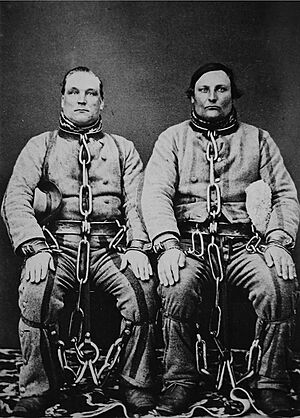Imprisonment facts for kids
Imprisonment is when a person is held against their will and cannot leave freely. This can happen for many reasons. Sometimes, it is done by the government or police as a legal punishment. Other times, it can be done by someone without legal power. This is called "false imprisonment" and is against the law.
Being imprisoned does not always mean being locked in a prison building. It can happen anywhere, even in a public place, if someone is held by force. For example, if someone is put in handcuffs, they are considered imprisoned. However, most often, imprisonment means being held in a prison as decided by law. In many places, more men are imprisoned than women.
Contents
History of Imprisonment
People have been held against their will for a long time. The reasons and ways of doing this have changed throughout history and in different parts of the world.
Early Imprisonment in Africa
Before European countries took control of parts of Africa, imprisonment was used differently. It was often used to hold people before a trial or to make sure someone paid back a debt. It was not usually used as a punishment itself, except in some places like the Songhai Empire. During the time of the slave trade, people were also imprisoned. When European countries colonized Africa, they used imprisonment to control people and to get forced labor. This use of prisons has continued to today.
Imprisonment in Australia
When European settlers arrived in what is now Australia, they brought their own ideas about law and punishment. They created courts and laws without asking the Aboriginal Australians, who had lived there for thousands of years. These new laws said that the settlers had power over the Indigenous people and their lands. When Aboriginal people did not agree with these laws or challenged them, they were often put in prison. This was a way to control and separate them.
Imprisonment in England and Wales
In English law, imprisonment means stopping someone from being free to move. A very old book from the 1600s, called Termes de la Ley, explains it like this:
Imprisonment is simply stopping a person's freedom. This can be in an open field, in wooden stocks, in a cage in the street, or even in a person's own house, as well as in common jails. In all these places, the person held is called a prisoner as long as they cannot freely go wherever they want.
If someone is imprisoned without a good legal reason, it is called false imprisonment. This is a serious wrong.
Being Released from Prison
When a prisoner has finished their time, they are released and can return to the outside world. Sometimes, they might start a period of probation, where they are supervised. A prisoner of war might be released when a war ends or through a prisoner exchange with another country. However, some prisoners, especially those with a life sentence, might never be released.
After being released, former prisoners can face challenges. They might need help with things like finding a place to live, getting food, or dealing with mental health issues. Some people who have committed serious crimes might have restrictions after they are released. For example, they might not be allowed to buy firearms or serve on a jury. There are often programs and resources to help people adjust after being released from prison.
See also
 In Spanish: Prisión para niños
In Spanish: Prisión para niños
- Criminal justice
- Detention (imprisonment)
- Life imprisonment
- Prison
- Prisoner of war
- Rehabilitation (penology)
- Restorative justice


